The first DC Superman imitator may have been Hourman (1940), who has the same original powers of Superman, at close to the same level.
But when Superman flew, Hourman was kind of left behind. Super strength, speed and durability weren’t enough to keep to the front ranks and they weren’t enough to even be considered an imitator except as an historical curiosity. But four years later DC would do it right.
“The tales of Superman, when he was a boy.” With those words Superman, the Man of Steel who was formerly the Man of Tomorrow became the boy of yesterday. The “first” Superman imitator that DC created is the closest, being the same person, younger. In a very real sense he was also another version of Captain Marvel Jr, who was first published in 1941.
Of course, Shuster and Siegel had different ideas what they wanted to do with the name Superboy, but they sold a billion dollar idea to DC for $300 and DC was going to run the show. So they put an eight year old (the same age Robin was when he started out) in Superman’s costume and in 1944 created the closest, most successful, and second-best imitation ever.
Although they were initially inconsistent with the period in which Superboy existed, basically, he was nostalgia for the thirties, and even kids who had never seen the times could be nostalgic for that time before the war, before their uncle died, before their older brother lost an arm, before their father hid food in the house in case they did it again.
Superboy’s stories took place in Smallville, a small town as opposed to the big city Metropolis. In this he reflected American nostalgia for small-town tranquility and morality which would hold until the publication of Peyton Place in 1956. In this 1930’s, Hitler, Mussolini, and the Rape of Nanking were never mentioned and didn’t seem to exist. There were no politics, no elections, and no one was Democrat or Republican. Even in the depths of the Great Depression no one was unemployed. There were no Hoovervilles and nobody rode the rails in search of a job or simply a meal. The only people who did ride the rails were professional bums and crooks because criminals always came from outside. Superboy survived partly because he recalled a simpler time that was largely made up.
That nostalgia was an important factor is shown by the fact Superboy was eight, while Superman has always been a bit under thirty. In other words, to be chronologically consistent, Superboy stories should have been twenty years before the date his story was published. In 1944 that would mean Superboy was active in 1924. But the flapper age of discontent just wouldn’t work: people had had enough of war and post war anxiety. The war was still on, then.
Superboy’s stories were about learning how to be Superman, about helping other people in town, and stopping the very large number of bank robbers who made their way to Smallville. As time went by issues like the approaching war and the appearance of supervillains like the Kryptonite Kid (who would later be the Kryptonite Man) were brought into the mix.
Superboy’s life imitated Superman’s. Instead of Lois Lane trying to prove Clark Kent was Superman, Lana Lang tried to prove Clark Kent was Superboy. Instead of Jimmy Olsen, Pete Ross was his pal. When Superman was bothered by an obnoxious blond bully at work, Clark was bothered by an obnoxious blond bully at school. Whenever something was tried out for one character, if it was successful, it was transferred to the other. Bizarro, Kryptonite, Lex Luthor, Krypto, and the list just goes on. Anything Superman met, Superboy would meet for the first time later. Anything Superboy met, Superman would meet for the first time later.
Shortly after Superboy was first published, though, the game board changed. As it happened, it reinforced the nostalgia element. The atomic bomb went off. Within four months, every trope of debate used between 1945 and the fall of the Soviet Union had already emerged. The end of the world, the immorality of such a weapon, mutual destruction, the need to disarm, the need to not disarm, alien disapproval at the existence of this weapon; all of them. Not only would they continue, they would be largely unchanged for the whole of that era.
Within a year of those explosions, Superman’s powers were ramped up. Before the atomic bomb, regular bombs and missiles could hurt Superman. After the atomic bomb Superman could fly through nuclear blasts and even into the heart of a star. He was no longer the epitome of advanced human evolution: like Glaucon, he was promoted from a man to a god.
Why the increase? Because Superman was always wrapped around what a person does with preponderant physical power. Where Superman in 1938 faced revolvers, knives, and occasional explosives, by 1946 he was facing atomic bombs.
So there was Superboy in Superboy and Adventure and Superman in Superman and Action. The story of Superboy would be extended in 1958 with the introduction of the first superhero team of the silver age, the Legion of Superheroes. Superman joined the Justice League of America in 1960. So by 1960 there were three streams of stories: Superboy and the Legion, Superman and the JLA, and Superman by himself. In each stream, he could destroy a planet.
In 1959 another family extension came as DC did for Superman what Fawcett had done for Captain Marvel, but with a cousin rather than a twin sister: they created Supergirl. Supergirl wore Superman’s costume but with a skirt instead of trunks and leggings. In this she paralleled Mary Marvel’s imitation of Captain Marvel’s costume.
There are many people who object to the sexism of Supergirl’s introduction, treatment by Superman, and general stories. While they have a point they don’t have the only one. Supergirl emphasized the cozy and domestic. Stories were about getting adopted, worrying about friendships, feeling lonely, why the latest guy she falls for isn’t right for her (hint, he’s dating Linda but she’s Supergirl), trying to set up her cousin with someone (as if she would know), pretending to really like Supergirl because everyone else does, being the only one at school not in a Supergirl costume, and so on. Basically, Supergirl’s stories were constructed much like Superboy’s. But Supergirl didn’t sell as well as Superboy, and she was never as central to the Legion of Superheroes as Superboy was.
But the finger was already out of the dike. Not only was there Supergirl, in 1958 the bottle city of Kandor was introduced. Superman was no longer the last surviving son, let alone child, of Krypton. Literally there were millions of them, six million, to be exact. Kandor even provided the Superman Emergency Squad, Kandorians who are expanded to a few inches tall, all wearing Superman costumes.
In 1962, the Phantom Zone appeared in Superboy. There were now an unlimited number of Kryptonian parallels to challenge the incredibly powerful Superman. One of them was his own relative, Kru-el.
In the Silver Age, Superman imitators were popping up everywhere. Lois Lane dreamed she had Superman’s powers and, in her dreams, put on a costume like Superman’s (only she covered her legs) and fought for truth, justice, and waking up. She would have a similar dream several times. In some stories she actually gets Kryptonian powers for a short time.
His cousin set him up with a grown woman who looked like her. Superwoman lived on a planet under an orange sun. She and Superman hit it off, but when he brought her back to Earth they discovered the yellow sun was poisonous to her. Since the Earth could not do without Superman the way her planet could do without her, she went back to her own planet and the guy who could fly anywhere in the universe virtually instantly never thought to commute.
Interestingly, Superwoman’s costume was a long-sleeved white swimsuit, green cape, gloves, and boots and a belt. On her chest was a circular ‘S’ symbol which, if you removed it…we’ll get back to that.
Three other Superwomen were used for significant story arcs: Kristen Wells, who came from the 29th century, Dana Dearden, who stole artifacts to get some Kryptonian power, and Lucy Lane, who wore a suit for the same effect. All three characters have been retired, at least until DC needs to keep its claim to the trademark “Superwoman” up to date.
In addition to the Phantom Zone villains, Superman imitators came in the form of the Superman Revenge Squad, who wore an imitation Superman costume but with the S shield made out of Kryptonite. On Earth 3 was Ultraman, who gained super powers whenever he came in contact with a chunk of Kryptonite for the first time. In 1985, a Superboy from Earth Prime was transferred to the only remaining universe DC had, and he was called Superboy Prime – later Superman Prime and still later Superboy Prime. Both villains wear costumes very similar to Superman’s.
But Superman’s influence went far wider than that. In 1953 Superman meets a space traveller who has a map showing the route from Krypton to Earth. It’s labelled “to my son.” So Superman thinks he has found his older brother, whose powers are the same as but considerably weaker than Superman’s. When the amnesia goes away, Superman discovers it’s not his older brother, it’s Halk Kar who comes from Thoron, a planet larger than Earth but smaller than Krypton. Halk went to Krypton, met Jor-El, who gave him a map how to get to earth – Jor-El had memorized it. Halk has a costume similar to Superman’s but with no S-shield. It has red shirt and leggings and blue cape, trunks, and boots. The story was so good that they would do it again in 1961, but in the meantime, they would create another Superman imitator.
In 1955 a scientist creates an electronic brain to communicate with the universe. What the brain does is pick a Martian at random. The scientist promptly has a heart attack and dies. Martian Manhunter does not buy a radio and contact his home planet, nor does he go to Superman or Supergirl and ask for a lift. He doesn’t fly home himself. If he can’t fly in space himself (DC is inconsistent about this) he could build an engineless ship and use his flight powers to get it to Mars.
Instead, J’onn J’onzz changes his spelling to John Jones and joins a police department that doesn’t do background checks. He then tramps through the back pages keeping a low profile as he catches crooks and stops aliens.
Manhunter comes from another planet, but it’s a heavy gravity world like Krypton (Mars has 1/3 Earth’s gravity), and he doesn’t change from red to yellow sun (same solar system). He has those powers because he was a member of a more advanced species. In other words, the original Superman explanation raises its head. He even has a Kryptonite, which is fire.
His superpowers include Superman’s strength, speed, durability in the face of anything that isn’t burning, flight, Martian vision (Superman’s x-ray, heat, and infrared vision), and superbreath. He also has extra powers like telepathy, the ability to turn invisible and/or intangible, and shape shifting. With those last powers, J’onn J’onzz doesn’t have to work in the public eye.
But in 1960, they were reviving the Justice Society of America, but “Society” was too snobby so they changed it to ‘League.’ And they were short of heroes. They took the standards, Superman, Batman, Wonder Woman, Green Lantern, and Flash. They added Aquaman who was not a good fit but at least had been published continuously since the Golden Age, but not Green Arrow who could make the same claim of continuity.
They also included Martian Manhunter, and they changed the character to get him into the League. Martian Manhunter had been avoiding the public eye. So they arranged that he got hit by a beam that changed him. Now when he turned invisible he would lose his superpowers. Forced to enter the public eye and despite having no public record to point to, he was allowed to join the League. The differences between him and Superman were toned down. He became the League’s “other” superman.
Later writers took hold of the character and added elements, but Oreos do not stop him from being a play on the Superman riff. After all, the biggest change they made was to add Miss Martian in 2006. Miss Martian is a younger still-trying-to-work-things-out niece to parallel Supergirl. She has rather more trouble because bigger problems make for better reading. We learn that Martians were green or white, and Manhunter is the last of the green Martians – so he’s the last son of green Mars to parallel the last son of Krypton. Eventually the white Martians will be the Phantom Zone for the Manhunter.
In 1961 another imitator came, he crash-lands, has a map how to get from Krypton to Earth labelled “to my son,” and has amnesia. He has the Kryptonian powers. He wears a costume of the same type as Superboy but with reverse coloring. No, Halk Kar has not returned, really, DC was just recycling ideas like it often did. Superboy names this teenager Mon-El.
Suspecting that Mon-El isn’t really Kryptonian, Superboy painted some cannonballs green. Mon-El succumbs, but when confronted by the cannonballs chopped in half to show their lead innards (I hope they aren’t antiques or anything), he suddenly gets his memory back and says he is from Daxam and is vulnerable to lead radiation. I don’t know what that is, either. But it’s fatal to Mon-El so Superboy saves him by putting him into the Phantom Zone, promising to release him when Superboy finds a cure. For the rest of his life, Superboy and later Superman will put the cure for Mon-El on the back burner.
A thousand years later, Braniac 5 had found a cure, leaving him free of the Phantom Zone forever. People complain about continuity problems for the Legion, but Mon-El suffers far worse because he could never have meet the person who sent him to the 31st century and thus would never meet the person who cured him, because Braniac 5 only knows about the Phantom Zone and Mon-El because of Superboy.
Mon-El and Daxam generally are so improbable that they eventually decided a group of Kryptonians went to Daxam and founded a society there. So a Superman imitation became an even closer imitation, not only because he was Kryptonian but because of Laurel Gand. When Supergirl was temporarily no longer existing ever, something was needed to fill the tiny gap she left in the Legion of Super Heroes continuity – never mind the lack of Superboy to inspire them.
What they did was get a distant relative of Lar Gand, Laurel Gand, otherwise known as Andromeda. She naturally has the Kryptonian set of powers, and she has Brainiac 5 as a boyfriend – so important a plot issue that it doesn’t exist in current continuity. It’s another gap in logic, like that Supergirl has all the Kryptonian powers in full on arrival on Earth and it took Superman so many years to get those powers that he was never Superboy. Laurel Gand completes her parallel to Supergirl because she’s been written out of continuity. Fortunately, that trick doesn’t always work.
The best-ever Superman imitation seems in retrospect to be a success waiting to happen, but in 1976 she could have easily wound up as a wishy washy imitation of an imitation like Supergirl. As it was, Power Girl was the cousin of Superman of Earth 2, and somebody learned from the sexism that plagued Supergirl. There weren’t the months of keeping her hidden, there wasn’t the years of learning how to use her powers. The instant we saw her she was 100% ready to take a leading role as had Superman.
Her name comes from a story in 1958 where Lois Lane dreams she gets super powers (you know which ones) again and takes on a secret identity. Instead of Superwoman, it’s Power Girl. She puts on a red wig to disguise herself to fight crime.
Our Power Girl’s costume seems to have come from the Superwoman who’ve we already mentioned. Change the gloves and boots from green to blue, the cape from green to red, move the belt from around the waist to the hips and you pretty well have Power Girl’s costume. If Superwoman’s circular S symbol is taken out, the famous cleavage hole is there.
Power Girl isn’t overly nice, she has always spoken her mind. She had a continuing verbal stosh with Wildcat, where early Supergirl had no continuing personal animosities at all. She had everything going for her except her universe. Crisis on Infinite Earths struck again and her universe was gone. They tried to make Power Girl a granddaughter of an Arion of Atlantis, which would actually make her related to Aquaman, not Superman. Nobody in fandom liked that. Eventually DC had to give in and she was returned to her status as a cousin of Superman and the last survivor of Earth-2. In her own comic she even got a superhero in training who’s still-trying-to-work-things-out in Terra, who came from another planet (via an underground civilization, a kind of parallel to the bottle city of Kandor).
Power Girl got her own series and everything was going fine until they ditched the character, invented another one with the same name, gave her a Disnified costume, and gave her way less personality. Which is odd, because there is one other set of Superman imitators and DC might learn from them…

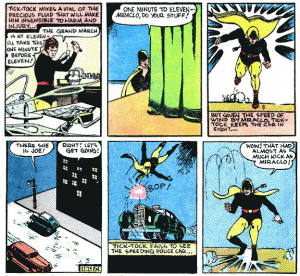
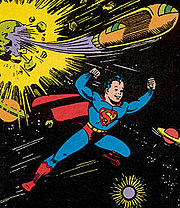
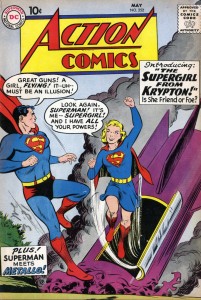
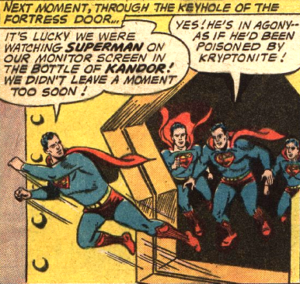
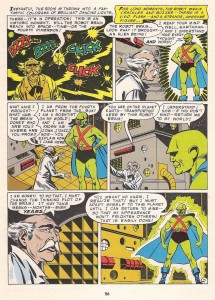
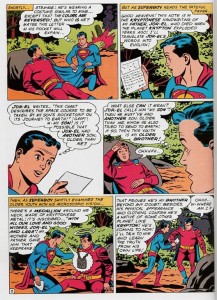

Comments are closed.